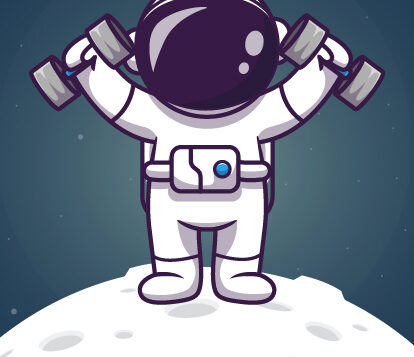Exercise. It’s a simple set of instructions we as humans force our bodies through as a way of maintaining our levels of fitness. Sometimes we exercise without completely recognising the fact that we are doing it. That’s right, simply walking down the road to the chippy, whether it’s one or ten minutes away, counts as exercise. But when the human body is tasked with tolerating the alien conditions in space, how does the astronaut keep themselves active in the land of stars?
Exercising in space differs massively to exercise on Earth and that comes down to one simple fact: the lack of gravity. According to NASA, lifting 200 pounds in space would be far easier due to the fact that the microgravity would cause the 200-pound equipment to feel lighter. Weightlessness in space can have its benefits and drawbacks. Astronauts need to work out for two hours per day in order to maintain their bone and muscle mass. Without any attempt to keep fit, it can be easy for the astronaut’s muscles to begin crumbling as the body becomes lazy.
In 2013, Canadian Space Agency (CSA) astronaut and commander Chris Hadfield shared his workout routine through the CSA YouTube channel, providing viewers with a remarkable insight into the daily life of an astronaut. Hadfield filmed his routine, showing us how gets his cardio fix and keeps his upper body muscles in good health. In terms of cardio, the treadmill serves as one piece of equipment which allows astronauts to perform their workout. The space treadmill is of course not your typical treadmill, in fact, a harness has to be worn to prevent the astronaut from floating away into outer space (physically and literally). On the other hand, the Advanced Resistive Exercise Device (ARED) allows astronauts to maintain their muscle and bone mass. Similar to an elliptical machine, the ARED ensures that the astronaut has the ability to work a number of muscles in the body, helping to prevent the body from laziness due to the low gravity conditions.
The deterioration of leg muscles is a potential problem for astronauts departing from the Earth into the unknown, considering how the legs won’t be required for use as much as they would be on Earth. To contain these issues, the ISS is also equipped with a stationary bicycle, again with a harness to ensure that the astronaut doesn’t float too high towards the ceiling. The bicycle comes with a monitor which allows the astronauts to keep a record of their fitness data. The data is sent directly to the trainers and doctors on Earth to make certain that the astronauts are keeping healthy.
Nutrition is just as vital in space as exercise is when it comes to the matter of keeping fit. The potential deterioration of bones is a challenge that must be dealt with as constantly and consistently as possible whilst on the space station. Foods rich in calcium like yoghurt are absolutely crucial otherwise astronauts risk a decrease of up to 20% in muscle mass and bone density. Fresh produce with a two-day shelf life is stored in refrigerators on board the spacecraft, astronauts acquire their source of vitamins through such fresh food whilst also consuming food in their natural form such as nuts which are simply packaged.
Exercise forms in space are rapidly evolving. So who knows… maybe in 20 years, PureGym in space will officially open. You never know.




